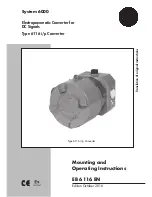
©
2015 Sensata Technologies
21
3.0 Operation
3.3 Understanding
Loads
The inverter can power most loads within its power rating, however, there are
special conditions that can cause a load to behave differently than expected.
Following are some common problems encountered when using this inverter.
USB loads
– When using the USB connector, be sure that the device you will
be connecting will accept 5 volts (
≤
750mA) and can be charged or powered
using another power source. The USB port can safely power and charge alot
of devices such as: MP3 players, mobile phones, and portable video game
players. However, some devices such as GPS receivers and some cameras
may not work and may even be damaged. Refer to the owner’s guide for
each device to determine its compatibility.
Motor loads not starting
– Some appliances, particularly those with
induction motors, require a much higher start-up surge than they do when
running. Pumps, freezers and refrigerators (compressors) are the most
common. The inverter may not be able to start some of these appliances
even though their rated current draw is within the inverter’s limits. If you
have the CSW1012 or CSW2012 and a motor-operated appliance refuses
to start, observe the VOLTS indicator on the digital display while you are
trying to start the appliance. If the display shows a battery drop below 11
volts while the inverter is trying to start the motor, this may explain why the
appliance won’t run. Make sure the length and diameter of the battery cables
are appropriate. Check that the battery connections are good and that the
battery is fully charged. If the cables are sized correctly, the connections are
good, and the battery is charged, you may need a larger battery bank (see
Loads turning on and off).
Loads turning off and on
– If a load starts but quickly turns off, then the
battery may not be able to deliver the necessary amperage to drive the load.
If the battery bank cannot deliver the necessary amperage to drive a heavy
load, the inverter will shut OFF due to low voltage (<10.5 VDC). The battery
voltage can then slowly rise back above the low voltage reconnect voltage
(11.8 VDC) causing the inverter to resume operation. As soon as the heavy
load draws the batteries down, this cycle will continue unless the load is
reduced or more batteries are added.
Loads too large
– Although the CSW Series inverter can provide high
surge power up to two times the rated output power, some appliances may
still trigger the inverter shutdown/protection system. In these instances, a
higher power inverter may be required.
Running several loads at once
– Sometimes the total surge requirement
of all the loads is higher than the CSW Series inverter can deliver. You may
want to turn them on individually to ensure that the inverter does not have
to deliver the starting current for all the loads at once.
3.4 System
Maintenance
Battery Charging
When possible, recharge your batteries when they are about 50% discharged
or earlier. This gives them a much longer life cycle than recharging when
they are almost completely discharged.
Inverter Maintenance
Routine maintenance is required to keep the CSW Series inverter operating
properly. Periodically you should:
• Clean the exterior of the unit with a damp cloth to prevent the accumulation
of dust and dirt.
• Tighten the screws on the DC input terminals.





































